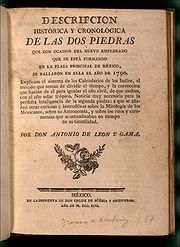
Felipe de Zúñiga y Ontiveros
Encyclopedia

Mexico City
Mexico City is the Federal District , capital of Mexico and seat of the federal powers of the Mexican Union. It is a federal entity within Mexico which is not part of any one of the 31 Mexican states but belongs to the federation as a whole...
– 1793, Mexico City) was a scientist
Scientist
A scientist in a broad sense is one engaging in a systematic activity to acquire knowledge. In a more restricted sense, a scientist is an individual who uses the scientific method. The person may be an expert in one or more areas of science. This article focuses on the more restricted use of the word...
, cartographer and publisher in New Spain
New Spain
New Spain, formally called the Viceroyalty of New Spain , was a viceroyalty of the Spanish colonial empire, comprising primarily territories in what was known then as 'América Septentrional' or North America. Its capital was Mexico City, formerly Tenochtitlan, capital of the Aztec Empire...
during the Spanish colonial period. He was also royal land surveyor and hydraulic and mining engineer.
Together with his brother Cristóbal, he took over the Imprenta Antuerpiana (Antuerpiana Press) in 1752. They remained as sole proprietors until late 1764. By 1767 this was the largest printing establishment in the Americas. In that year Manuel Antonio Valdés y Munguía joined the business. After Zúniga's death in 1793, Valdés took on Luis Abadiano
Luis Abadiano
Luis Abadiano y Valdés was a 19th-century printer and publisher in Mexico City, one in a long line of printers, publishers, booksellers and book collectors traceable back to the famous Humanist and bibliographer Juan José de Eguiara y Eguren, founder of the printing house Biblioteca Mexicana in...
as a partner (about 1821). At the time of Valdés's death in 1831, the firm was the oldest publisher in Mexico.
From 1762 to 1780 Zúniga y Ontiveros published Efemérides calculadas y pronosticadas según el meridiano de México. These octavo volumes contained information on eclipses and other astronomical phenomena. In 1767 he began publishing Guía de Forasteros, a kind of almanac, which was published each year through 1792, although the name was changed to Calendario mensual (Monthly Calendar). He also published an updated version of Carlos de Sigüenza y Góngora
Carlos de Sigüenza y Góngora
Carlos de Sigüenza y Góngora was one of the first great intellectuals born in the Spanish viceroyalty of New Spain. A polymath and writer, he held many colonial government and academic positions.-Early career:...
's map of the valley of Mexico.
Zúniga paid much attention to detail in the works he published, including the typefaces. He spent 50,000 pesos acquiring type from Antwerp and Madrid. He was the first to use type cast in New Spain, by the clockmaker and printer Dimas Rangel, with whom Zúniga edited Estatutos de la Real Academia de San Carlos (Statutes of the Royal Academy of San Carlos) (1785).
He was the author of Bomba hidráulica para levantar las aguas (Hydraulic Pump to Raise Water) (1770) and a sonnet published in Fénix de los mineros ricos (1779).
Other works published by Zúniga
- Neve, Felipe de, Reglamento para el Gobierno de la Peninsula de Californias (1784) — government regulations for the Californias
- Palóu, Francisco, Relacion Historica de la Vida y Apos tolicas Tareas del Venerable Padre Fray Junipero Serra, y de las Misiones que fundó en la California Septentrional, y nuevos establecimientos de Monterey (1787) — the life and work of Father Junípero Serra, founder of many California missions
- León y Gama, Antonio de, Descripción histórica y cronológica de las dos piedras que con occasion del nueve empedrado que se está formando en la plaza principal de Mexico (1792) — a description of the Aztec calendar stone shortly after it was rediscovered

